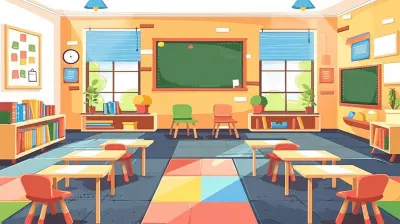Building Empathy: Teaching Students to Understand and Care for Others
4 July 2025
Let’s face it—there’s a whole lot of noise in this world. Everyone’s busy shouting to be heard, and sometimes, we forget the magic of listening, understanding, and caring. That’s empathy. Sounds simple, right? Feel what others feel, walk a mile in their shoes (even if they’re crocs), and respond with kindness. But guess what? Empathy isn’t something we’re all born knowing how to do. It’s a skill. And like any skill—juggling, riding a bike, or mastering the yo-yo—it can be taught. Especially to students. Why? Because they’re the future empathy warriors we so desperately need.
So buckle up, folks. We’re about to dive into the colorful, slightly chaotic, and utterly heartwarming world of building empathy in classrooms.
What Even Is Empathy, Anyway?
Let’s start with the basics. Empathy isn’t sympathy. It’s not just feeling sorry for someone. Nope. Empathy is stepping into someone else’s emotional sneakers and saying, “Hey, I get it. I feel what you’re going through.”It comes in different flavors:
- Cognitive empathy: Understanding what someone else is thinking.
- Emotional empathy: Feeling what someone else is feeling.
- Compassionate empathy: Taking action to help someone based on that understanding and feeling.
Teaching students empathy means helping them recognize emotions (in themselves and others), communicate kindly, and actually care about what others are experiencing.
Sounds like a lot? Trust me—it’s not only doable, but it’s a total game-changer.
Why Empathy Should Be a Core Subject (Like, Seriously)
You know what we teach in schools? Algebra, grammar, history timelines… all important stuff. But emotional intelligence? Interpersonal skills? Often left to chance.That’s wild.
Empathy helps students:
- Collaborate better (group projects become less of a nightmare)
- Reduce bullying and conflict (because they understand and value others)
- Develop stronger communication skills (bye-bye, awkward misunderstandings)
- Boost self-awareness and perspective-taking
And the biggie: it helps them grow into kind, respectful, and resilient human beings. Who wouldn’t put that on a résumé?
Classroom Crayons and Kindness: How to Teach Empathy Like a Pro
Here’s where the fun starts. No, you can’t just sit a student down and say, “Be more empathetic.” That’s like telling a cat to fetch—a little unproductive.You’ve got to make it real. Tangible. Engaging. Let’s break it down.
1. Model, Model, Model (Like You’re on an Emotional Runway)
Students watch. Constantly. So, teachers? You’re the empathy MVPs. Show them how to listen without interrupting. Share stories about your own feelings. Speak kindly, even during frustration.Empathy is caught, not just taught.
2. Use Stories Like Empathy Time Machines
Books, movies, and personal stories are goldmines for empathy exercises.Encourage students to step into the lives of characters. Ask questions like:
- How do you think they felt in that situation?
- What would you have said or done differently?
- Can you relate to that experience?
Suddenly, reading becomes a portal to walking in someone else’s shoes. Bonus: you're also fueling literacy. Boom. Two birds, one empathetic stone.
3. Role-Playing: Because Pretending is Powerful
Time to bring out the drama skills! Create scenarios where students act out different perspectives. Think: losing a pet, being excluded from a game, or helping a new student fit in.Let them experience different viewpoints. It’s kinda like empathy boot camp—with costumes.
4. Start a “Walk in My Shoes” Journal
Give students a journal where they reflect on their interactions, thoughts, and feelings. Ask prompts like:- What was a moment today when you helped someone?
- Did you notice someone feeling left out?
- How did someone make you feel seen or heard?
This daily or weekly reflection helps students build emotional literacy and take ownership of their actions.
5. Celebrate Differences Like They’re Superpowers
Diversity isn’t just a buzzword—it’s a classroom reality. Celebrate cultural, racial, and neurological differences by hosting heritage days, inclusive curriculum content, and guest speakers from different backgrounds.Help students understand that everyone’s story is unique and valuable. The ultimate empathy lesson? Realizing we don’t have to be the same to care about each other.
Tech with Heart: Using Digital Tools for Empathy
Wait—tech for empathy? Isn’t tech the thing that’s making people less connected?Not if we use it right.
There are some amazing digital tools and apps that focus on empathy-building:
- ClassDojo’s Mojo Stories: Short animated videos with follow-up questions.
- Peekapak: SEL curriculum with adorable characters and interactive storytelling.
- Empatico: Connects classrooms across the globe for shared projects and virtual exchanges.
When students chat with kids in another country or learn about different cultures through stories and images, empathy expands beyond their immediate world.
It’s empathy... gone global.
The Wobbly Bits: Challenges to Teaching Empathy (And How to Overcome Them)
Okay, let’s be real. Not every student is going to transform into an empathy Jedi overnight. Some kids come from backgrounds where they’ve rarely received empathy. Others might be dealing with trauma, or simply don’t know how to express feelings.Here’s what helps:
- Create safe, consistent classroom environments.
- Use restorative practices instead of punitive measures.
- Don’t force sharing—some kids need time.
- And most importantly, be patient. Empathy takes time to grow.
Think of it like a sourdough starter. With the right ingredients and a little bit of love, it will rise.
Empathy at Home: Partnering with Parents
Empathy isn’t just a school thing. Parents and caregivers are crucial allies in this mission.Schools can support them by:
- Sending home empathy-building activities
- Hosting parent workshops on emotional literacy
- Sharing stories from the classroom that highlight students’ kindness and compassion
When students see empathy being valued everywhere, it becomes second nature. Like tying shoelaces—at first clumsy, then automatic.
Empathy in Action: Real Stories That Hit You in the Feels
Let’s paint a picture.A 4th-grade student notices his classmate crying after recess. Instead of ignoring it or teasing (like might’ve been the case a year ago), he walks over, sits beside her, and says, “It’s okay to feel sad. Want to talk about it?”
That, right there, is the power of empathy taught and learned.
Or how about a middle school class that starts a “kindness chain” where they pass notes with compliments and encouragement, turning a grumpy Monday into a sunshine parade?
These are small moments on the surface—but their ripple effects? Massive.
So... Is Teaching Empathy Worth It?
100%, without a doubt, yes.Teaching empathy isn’t about adding more to a teacher’s overflowing plate. It’s about changing how we teach everything else. It’s about raising humans who care—not just about grades and gold stars—but about each other.
When we make empathy part of our daily classroom language, we’re not teaching a lesson. We’re building a culture.
A culture of understanding. A culture of kindness. A culture where people pause, listen, and say, “Hey, I care.”
So yeah, empathy might not be on the standardized test. But it just might be the most important subject we ever teach.
Final Thoughts: The Empathy Revolution Starts Small
You don’t need fancy programs, glittery anchor charts, or superhero capes (though those are fun). The key to teaching empathy? Start where you are. With who you have. And keep practicing.Every time you make space for a student to feel heard, every story you unpack together, every time you model understanding—you’re building a better world.
One kind thought, one listening ear, one compassionate heart at a time.
Let’s raise a generation of humans who aren’t just smart—but deeply, wonderfully, wildly empathetic.
all images in this post were generated using AI tools
Category:
Character EducationAuthor:

Olivia Chapman
Discussion
rate this article
1 comments
Corin Wells
This article beautifully highlights the importance of empathy in education. Teaching students to understand and care for others not only enriches their lives but also fosters a more compassionate world. Thank you!
July 15, 2025 at 12:33 PM

Olivia Chapman
Thank you for your kind words! I'm glad you found the article impactful. Empathy truly is essential for creating a compassionate world.


